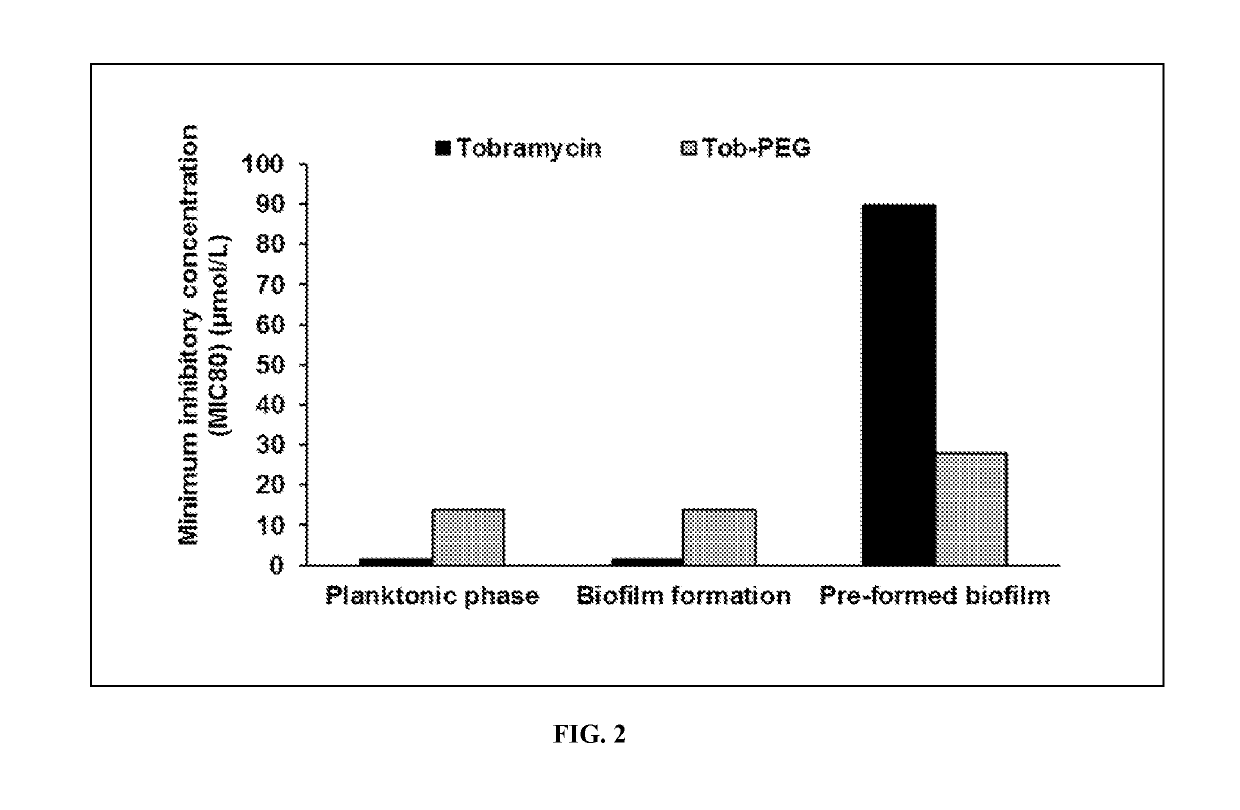Compounds for treating biofilm infection
a biofilm infection and aminoglycoside technology, applied in the field of pharmaceuticals and medicine, can solve the problems of difficult management, difficult clinical treatment of biofilm infections, and often life-threatening chronic infections, and achieve the effects of reducing or stopping the antibiotic, enhancing the antibacterial effect of an aminoglycoside to treat established biofilms, and improving the efficacy
- Summary
- Abstract
- Description
- Claims
- Application Information
AI Technical Summary
Benefits of technology
Problems solved by technology
Method used
Image
Examples
example 1
Materials and Methods
[0056]Microorganism Culturing
[0057]Pseudomonas aeruginosa (P. aeruginosa) PAO1 was used throughout the study. Blood agar and Brain heart infusion (BHI) solution were used for culturing P. aeruginosa.
[0058]Prior to each experiment, P. aeruginosa was cultured on blood agar for 18 h at 37° C. A loopful of the overnight bacterial growth was inoculated into BHI medium, and incubated for 18 h in an orbital shaker (80 rpm) at 37° C. The resultant growth was harvested, washed twice in Phosphate Buffered Saline (PBS, pH 7.4) and resuspended. The concentration of P. aeruginosa was adjusted to 1×107 cells / mL by spectrophotometry and confirmed by hemocytometric counting.
[0059]Biofilm Formation
[0060]P. aeruginosa biofilm was developed as described (Bandara et al., 2010) with minor modifications. Commercially available pre-sterilized, polystyrene, flat bottom 96-well microtiter plates (BD Biosciences, California, USA) were used. At first, 100 μL of a standard cell suspension...
example 2
Polyethylene Glycol Conjugated Tobramycin has Greater Antimicrobial Activity Compared to Tobramycin in P. aeruginosa Biofilms
[0077]Synthesis of Tob-PEG
[0078]Following synthesis, we utilized nuclear magnetic resonance (NMR) spectroscopy to obtain the H-NMR spectrum (FIG. 1) (Szilagyi, 1987) and help confirm the identity of Tob-PEG. In FIG. 1-A, the multiplet at around 5.45 ppm could be assigned to the H at A1′, while multiplet of 4.9 ppm corresponds to the H at C1″; the two H at A3′ had two correlations with the signals at about 2.1 ppm and 1.75 ppm; and the two H at B2 were linked with the peaks at about 2.05 ppm and 1.45 ppm. Compared with H-NMR spectrum of tobramycin, the peaks from 1.4 ppm to 2.1 ppm were slightly shifted to left in the H-NMR spectrum of Tob-PEG, but overall, the NMR spectrum kept a similar pattern as seen with tobramycin. In the Tob-PEG it could be observed that the characteristic three peaks signals of tobramycin were retained and no similar peaks were observed...
PUM
 Login to View More
Login to View More Abstract
Description
Claims
Application Information
 Login to View More
Login to View More - R&D
- Intellectual Property
- Life Sciences
- Materials
- Tech Scout
- Unparalleled Data Quality
- Higher Quality Content
- 60% Fewer Hallucinations
Browse by: Latest US Patents, China's latest patents, Technical Efficacy Thesaurus, Application Domain, Technology Topic, Popular Technical Reports.
© 2025 PatSnap. All rights reserved.Legal|Privacy policy|Modern Slavery Act Transparency Statement|Sitemap|About US| Contact US: help@patsnap.com



